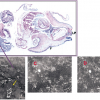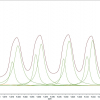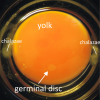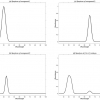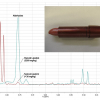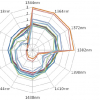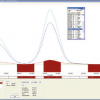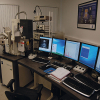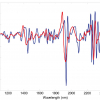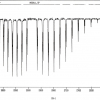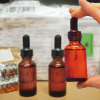Articles and Columns
BBCEAS is a new cavity-based absorption technique that uses broadband sources rather than lasers. This offers potential improvements in signal-to-noise but often lower spectral resolution compared to techniques where the laser wavelength is scanned. The article concentrates on liquid-phase applications, an interesting new area since most cavity-based absorption studies have been performed on gas-phase species up to now.
As nanotechnology grows in importance, the need for rapid, easy and automated analytical methods to investigate new nanomaterials increases. Near infrared (NIR) spectroscopy has the potential to replace numerous methods for the investigation of a wide range of nanostructured materials and with particular potential in the area of PAT.
M. Hässig,a K. Altwegg,a H. Balsiger,a B. Schläppi,a J.J. Berthelier,b B. Fiethe,c S.A. Fuselier,d J. De Keysere and M. Rubinf
aPhysikalisches Institut, University of Bern, Sidlerstr. 5, CH-3012 Bern, Switzerland
bLATMOS, Saint Maur, France
cInstitut of Computer and Network Engineering, Technische Universität Braunschweig, Germany
The authors describe the use of a range of complementary methods to explore cellular, physiological and behavioural mechanisms underlying Al accumulation and toxicity, and its eventual fate, using the pond snail as a model organism.
Raman spectroscopy is to be used as one of the analytical techniques for the European Space Agency’s ExoMars mission to identify the geological and biogeological spectral signatures that could herald the presence of extinct or extant life on Mars. The article looks at the benefits of Raman spectroscopy for this and the research on Earth to build knowledge of the spectra of organisms living in extreme conditions here.
Peter Jenks is concerned at the lack of mutual help available on the Internet within the field of analytical chemistry. Other fields, outside science, have strong communities where enthusiasts give freely of their advice and time; why not in analytical chemistry? Please tell us your views by adding a comment to this column article.
1H NMR spectra are usually interpreted by hand, which is very time consuming, and can become a process bottleneck in fields such as high-throughput NMR. Greater automation of the spectral analysis process has become essential if NMR is to be of value as a high-throughput analytical method in the future.
This article describes the analysis of cells from the pulp of the feather by IR spectroscopy and the possibility of using infrared imaging of intact eggs to determine bird gender.
Tony Davies and Tom Fearn present “A digression on regression”. They turn their attention to one of the simpler regression techniques, Classical Least Squares (CLS). As well as an explanation of the basics, they explain why it is not often used in spectroscopy, and give the pros and cons of various regression techniques.
Nati Salvadó, Salvador Butí and Trinitat Pradell have used a number of techniques to investigate changes in pictorial techniques in Catalan paintings in the 15th century. The combination of different techniques is of particular value. The use of synchtrotron radiation as a light source is also an advantage.
Dirk Lachenmeier, Marina Gary, Yulia Monakhova, Thomas Kuballa and Gerd Mildau describe “Rapid NMR screening of total aldehydes to detect oxidative rancidity in vegetable oils and decorative cosmetics”. Lipid oxidation produces rancid products, which are both unpleasant and potentially toxic. The authors describe the use of NMR to screen food and cosmetic products. Whilst, vegetable oils were generally found to be in good condition, German women may wish to be careful of their lipstick, especially if they have had kept it for a while!
Roumiana Tsenkova introduces us to the field of “Aquaphotomics” which she has pioneered. The potential information held by water in biological systems coupled with NIR spectroscopy’s ability to extract a large amount of information at once, means that Aquaphotomics may be of great importance in the study of living organisms.
Time for a good whinge (“complain persistently and in a peevish or irritating way”—Oxford Dictionaries Online) and to get a little controversial. Having had a year to look at the resources available to us to help educate our budding spectroscopists, I have been disappointed that much of the educational resources available online appear incomplete or outdated. For a generation of students brought up in schools with interactive whiteboards, good quality spectroscopic teaching materials of this nature are almost non-existent.
In recent editions of SE I have asked searching questions about the evolution of ISO 17025 and the role of accreditation bodies. By chance, I received a copy of an article by Gary Price which suggested that here was someone else who wasn’t convinced by the status quo. I contacted him and found that he is a metrology specialist who has advised Australian governments on the measurement infrastructure requirements of modern chemical measurement. I felt that the readers of this column would enjoy and may like to comment on his views. I asked him to produce the following short review of the arguments presented in the main articles.—Peter Jenks
The presence of trace elements in gasoline can lead to a number of detrimental effects both on the automobile engine using the fuel as well as the environment. Trace elements can dramatically decrease engine performance by negatively impacting the operation of the engine’s electronic sensors that control the combustion process. Additionally, environmental pollution occurs when trace elements are transported from the engine to the environment via emissions. The analysis of these elements is therefore crucial to ensure that the performance of the engine is not affected by the fuel and that environmental damage does not occur when trace elements are released from the engine via emissions. This article discusses how modern inductively-coupled plasma (ICP) technology surpasses the performance of traditionally used atomic absorption spectroscopy (AAS) techniques to ensure optimal fuel quality.
Information on the detailed chemical composition, structure and morphology of environmental particles, and especially airborne particulate matter (PM), facilitate the understanding of their reactivity, sources, transport and changes of chemical species and, hence, prediction of their likely impact on the environment and human and animal health. The analysis techniques for environmental particles can broadly be divided into two groups: bulk (for example, water-soluble ionic content by means of ion chromatography for PM, elemental concentrations by means of X-ray fluorescence spectrometry for all environmental particles, chemical structural information by means of X-ray diffraction for larger environmental particles, such as sediments and sands etc.) and micro-analytical techniques, whereby the character of any single particle can be probed.
The counterfeiting of medicines is an increasing world wide problem as a great danger to public health. Counterfeit medicines are imitations of their authentic counterparts so that both physical characterisation and chemical analysis are required to discriminate between them. In this respect, near infrared (NIR) spectroscopy is ideally suited to screening for counterfeit medicines because it is non-destructive, fast, requires no sample preparation, and provides a fingerprint of the physical and chemical composition of a product.
Spectroscopy is the measurement of the interaction of radiation with matter before or after spectral dispersion. This has been studied variously by physicists and chemists, has wide applications outside these traditional disciplines and cannot be owned by any particular community. The subject embraces both science (including mathematics) and technology (including computing) and contains many examples of differences, not always understood, between these cultures. It illustrates the unchanging and universal character of the relevant science, which is increasingly revealed by advances in the relevant technology.
Doping control authorities and sports drug testing laboratories are frequently confronted with the illicit use of performance-enhancing therapeutics and therefore various analytical strategies have been developed to detect a misused drug and/or its metabolic product(s) in blood or urine specimens. Besides the administration of clinically approved drugs prohibited in sports, new drug candidates currently undergoing early or advanced clinical trials have also been the subject of investigations concerning their prevalence and abuse by athletes.
The 33rd meeting of the Reference Material Committee of ISO, ISO/REMCO was held in Hangzhou (China) from 3 to 7 May 2010, and was hosted by the Standardisation Administration of China and the China Association of Standardisation. ISO/REMCO now has a membership of 70 members of the International Organisation for Standardisation (ISO) and liaison with 18 international organisations and seven ISO-internal committees. The new ISO TC liaison introduced at this meeting is with ISO/TC 158 “Analysis of gases”, with Dr Adriaan van der Veen acting as the REMCO liaison officer.



